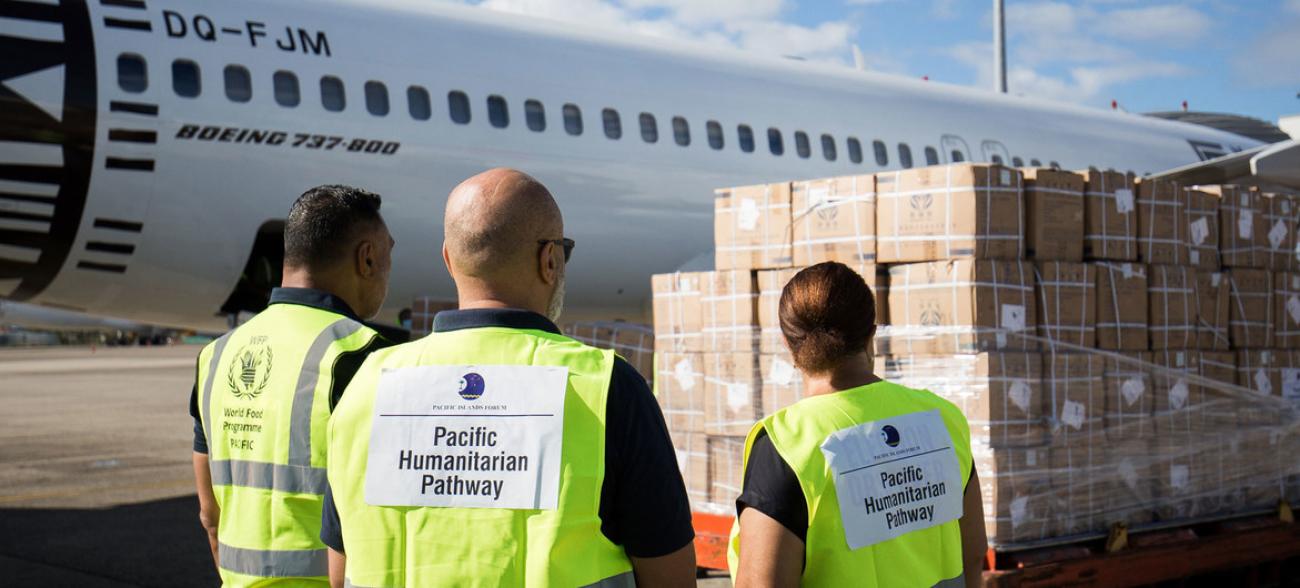The supplies were transported on behalf of the Pacific Islands Forum, the region’s premier political and economic policy organization.
With commercial air services greatly reduced due to airport closures, and other measures to prevent further spread of the disease, the 18-member bloc has established a platform to facilitate the timely and rapid movement of medical and humanitarian assistance, known as the Pacific Humanitarian Pathway on COVID-19.
Protecting people, supporting health systems
“The humanitarian air service flights are a welcome demonstration that the Pacific Humanitarian Pathway on COVID-19 is doing what leaders intended - protecting citizens and supporting health systems”, said Dame Meg Taylor, Pacific Islands Forum Secretary General.
The Pacific region is comprised of more than 20 countries and territories scattered across an area that represents roughly 15 per cent of the earth’s surface.
Therefore, air and sea transport “is nothing short of a lifeline”, according to Jo Pilgrim, Director of WFP’s Pacific Multi-Country Office, which is located in Fiji.
Impact of COVID-19
Although border closures have helped curb the COVID-19 threat, she said impacts have been significant, particularly as the region relies on tourism revenue.
“It's also affected international supply chains, especially for air cargo, and this makes it very difficult for Pacific governments and international aid organizations to import goods, especially medical equipment like the personal protective equipment that you need to protect our health workers”, Ms. Pilgrim told UN News.
“Even shipping routes across the Pacific, which are major avenues for the importation of food and fuel, for example, have been affected. Even though they are still running, the services are reduced, and the costs are increasing.”
WFP support to nations
Unlike other WFP operations, the Pacific Office does not work on food aid distribution or food assistance. Instead, it supports governments with emergency preparedness in a region that is highly susceptible to cyclones and other extreme weather events.
During the pandemic, staff have been assisting national authorities in three areas: establishing COVID-19 call centres and tele-health initiatives, conducting remote surveys on food security at the household level, and in logistics.
“A good example for logistics is that with the shut-down of the aviation sector affecting the ability of governments and aid organizations to import goods, we have established the Pacific humanitarian air service which will deliver cargo to those countries where there are no viable commercial options available for the importation of freight by air”, said Ms. Pilgrim.
Filling the gap
The Pacific humanitarian air service will transport medical items, medicines, and equipment on behalf of UN agencies such as UNICEF and the World Health Organization (WHO), as well as the International Federation of the Red Cross.
Flights will also deliver supplies on behalf of countries, coordinated through the Pacific Islands Forum Secretariat and the Pacific Humanitarian Pathway for COVID-19.
“Normally, humanitarian air services only move cargo on behalf of humanitarian organizations”, Ms. Pilgrim explained. “But in this particular case in the Pacific, because of the unprecedented circumstances we find ourselves in, where no one can get anything on a plane, we’re also moving medical cargo for the governments.”
Ms. Pilgrim expressed hope that commercial flights will be back in the air soon.
“We don't want to do anything that would contradict this or that would disincentivize the aviation sector commercially”, she said, “so all the flights that we will operate will be limited as much as possible to those sectors without commercial options.”
The Pacific humanitarian air service is currently funded by Australia and the United States, and the hope is that other donors will step up.
“WFP is a voluntary-funded organization and we rely completely on donations from governments and the private sector, so we can keep flying for as long as we've got funds coming in,” said Ms. Pilgrim. “And hopefully we will have enough support from the donor community to allow us to fill the gap in the aviation sector until it's restored and our services are no longer required.”





